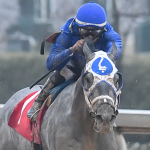
Preakness Quick Sheet: Get to Know the 2021 Preakness Horses

Horse racing is a sensory sport. So much of its excitement is generated from the colors that fill your eyes, the pungent smell of horse, and perhaps above all, its distinct sounds. The rhythmic beating of hooves in the dirt during morning training, punctuated by steady snorts; shouts and cheers from you and your friends as the longshot you have 10 bucks on crosses the finish line first; birds in the trees on a green spring morning leading in the herd. As much as I love the roar of the crowd during a close-finishing race, for me there is one sound that is the most captivatingly powerful of all.
Before commencing the Godolphin Flying Start (GFS) program, my racing industry background was primarily in journalism and communications. I had galloped a bit for a trainer and worked hands-on with plenty of horses, but I had never spent time around broodmares or foals. I had not even witnessed a foal being born, much less aided with a foaling.
The U.S. phase for GFS is comprised of a series of work rotations. These vary from helping in the breeding shed with stallions; working with Godolphin’s layup and rehab trainer, Johnny Burke; pitching in at an aftercare facility; and two weeks of foaling at WinStar Farm.
At the beginning of the program in 2018 we took anatomy, reproduction, and other veterinary courses at University College Dublin. I was moderately prepared for foaling, but classroom experience cannot be fully absorbed without getting your hands dirty. There are no lessons like real life ones – walking down barn aisles at 1 a.m., shining a light into each stall, checking a mare’s udder to see if her teats are waxing up or her coat has a sheen of sweat. These are indicators that a baby is on the way. Then momma starts pacing her stall, sometimes for hardly any time at all and other times for hours.
I have all the respect in the world for broodmare managers. It’s an important job keeping pregnant mares as comfortable as possible, their rotund bellies heavy with a future racehorse folded up inside. Caring for a mare from the time of breeding, checking that she has conceived, to her foaling date must generate the same amount of worry as realizing you’ve left the stove on all day and hoping you won’t come home to find your house burnt down.

The first foaling I assisted with was accompanied by many emotions. Overwhelmed, trying to shake loose all the textbook material stuck somewhere inside my brain; delighted that I was going to be part of bringing a new life into the world; concerned that I would get in the way or make a mistake.
The process goes something like this: someone beside you patiently explains how to check the position of the foal, where to grasp its spindly legs as they emerge, and when to pull as the mare pushes. After the foal slides out completely into this chilly and startling new world, you are guided on running latex-gloved fingers down its narrow nose, clearing any fluids to allow for full first breaths. Meanwhile, someone is rubbing the foal’s ribs to stimulate its body entirely to life.
And then you hear the sound – the most beautiful one of all. The mare, once she has rested momentarily to catch her own breath, looks back and sees her baby for the first time. Her entire face lights up, suddenly fully present. Her eyes widen with an emotion I can only imagine is the equine form of joy. Ears pricked, she lets out a loving nicker.
I hesitate to anthropomorphize animals, acknowledging their instincts do not allow them to process thoughts the same way as humans. But I’m not fooled into thinking they do not have emotions or cannot feel a sudden rush of tenderness, attachment, and gravitation to protect and nurture.
I had the opportunity to hear that beautiful sound 11 times during my two weeks in the foaling unit at WinStar. That’s nothing compared with the experienced horsemen and women who have been at 500-plus foalings, but I have a feeling it never gets old.
In the midst of our current circumstances, life can feel stagnant. So if you need a bit of hope, picture this: a safe foaling is the beginning of a dream. We might not have a lot of racing at the moment, but there are future racehorses being born today, tomorrow, and the day after. A few of them will walk into the starting gate for a running of the Kentucky Derby, the sounds of “My Old Kentucky Home” amplified from a grandstand filled with thousands of people.